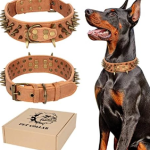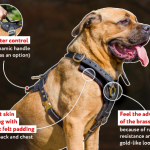The Cane Corso: A Comprehensive Guide to This Majestic Breed
Introduction
The Cane Corso is a striking breed with a rich history and a commanding presence. Originating from Italy, this breed is renowned for its strength, loyalty, and versatility. As a descendant of the ancient Roman Molossers, the Cane Corso has been an integral part of Italian history and culture. In this comprehensive guide, we’ll explore the Cane Corso’s origins, physical characteristics, temperament, training needs, and more to provide a well-rounded understanding of this remarkable dog.
Historical Background
Ancient Roots
The Cane Corso’s lineage traces back to the Molossus dogs of ancient Rome, which were used for guarding and as war dogs. The name “Cane Corso” itself is derived from the Latin word “Cohors,” meaning “protector” or “guardian.” These dogs were bred for their strength and courage, qualities that have been retained in the breed’s modern descendants.
Evolution in Italy
During the Middle Ages, the Cane Corso was primarily used for hunting large game such as wild boar and deer. Their robust physique and powerful bite made them excellent for this role. Over the centuries, the breed’s role shifted to that of a farm guardian and protector of livestock, which contributed to their reputation as dependable and courageous animals.
By the mid-20th century, the Cane Corso faced a decline in popularity due to changing agricultural practices and a reduction in their working roles. However, dedicated enthusiasts and breeders worked to preserve the breed, leading to its resurgence in the late 20th and early 21st centuries. Today, the Cane Corso is recognized worldwide and cherished for its versatility and loyalty.
Physical Characteristics
Size and Build
The Cane Corso is a large and powerful breed, with males typically weighing between 110 and 130 pounds and females between 90 and 110 pounds. They stand about 23.5 to 27.5 inches at the shoulder, with males generally being larger than females. Their muscular build is complemented by a broad chest, strong legs, and a solid, rectangular frame.
Coat and Color
The Cane Corso has a short, dense coat that lies close to the body, providing them with a sleek and polished appearance. Their coat colors are diverse and include black, gray, fawn, red, and brindle. Some Corsos may also have white markings on the chest, toes, or face, although extensive white markings are less common.
Head and Expression
One of the Cane Corso’s most distinctive features is its head. They have a large, square-shaped head with a pronounced stop and a strong, well-defined jaw. The breed’s expression is both alert and dignified, reflecting their intelligence and seriousness. Their eyes are almond-shaped and can be dark or amber, contributing to their expressive and intense gaze.
Ears and Tail
Historically, Cane Corsos had their ears cropped and tails docked, but today, these practices are becoming less common, with many owners opting for natural ears and tails. When left natural, the Cane Corso’s ears are medium-sized, triangular, and set high on the head. Their tails are typically docked in many countries, but in places where docking is prohibited, the tail is long and tapering, carried low or slightly curved.
Temperament and Personality
Loyalty and Protection
The Cane Corso is known for its unwavering loyalty to its family. This breed forms strong bonds with its owners and is highly protective of them. They are naturally inclined to guard their home and loved ones, making them excellent watchdogs. Their protective nature means they are often cautious around strangers, but with proper socialization, they can be friendly and welcoming.
Intelligence and Trainability
Cane Corsos are intelligent dogs that respond well to training. They thrive on mental stimulation and are quick learners, which makes them highly trainable for various tasks, from obedience to advanced commands. However, their intelligence can also lead to stubbornness, so consistent, positive reinforcement training methods are essential.
Activity Level
Given their history as working dogs, Cane Corsos are energetic and require regular exercise to stay healthy and happy. Daily walks, playtime, and mental challenges are important to keep them engaged and prevent boredom-related behaviors. They enjoy activities that involve physical exertion and problem-solving, such as agility training or interactive toys.
Socialization Needs
Early socialization is crucial for the Cane Corso. Exposure to different people, animals, and environments helps them develop into well-rounded adults. Proper socialization helps mitigate any tendencies toward shyness or aggression and ensures that they are comfortable and confident in various situations.
Health and Care
Common Health Issues
Like all breeds, Cane Corsos are prone to certain health conditions. Some common health issues include hip and elbow dysplasia, bloat (gastric dilatation-volvulus), and certain eye conditions such as entropion. Regular veterinary check-ups, a balanced diet, and appropriate exercise can help mitigate these risks.
Grooming
The Cane Corso’s short coat is relatively low-maintenance compared to longer-haired breeds. Regular brushing helps keep their coat healthy and reduces shedding. Additionally, routine dental care, nail trimming, and ear cleaning are essential components of their grooming routine.
Diet and Nutrition
A well-balanced diet is vital for maintaining the Cane Corso’s health and vitality. High-quality dog food that meets their specific nutritional needs, based on age, size, and activity level, is recommended. Consulting with a veterinarian can help ensure that their dietary requirements are met and prevent issues such as obesity.
Living with a Cane Corso
Space Requirements
Due to their size and energy levels, Cane Corsos are best suited to homes with ample space. They thrive in environments where they have room to move and play. While they can adapt to apartment living, they require frequent outdoor exercise to meet their physical and mental needs.
Interaction with Children and Other Pets
Cane Corsos can be good with children, especially if they are raised with them from a young age. Their gentle nature with family members contrasts with their protective instincts toward strangers. When it comes to other pets, early socialization plays a key role in ensuring positive interactions. Cane Corsos can get along well with other dogs if properly introduced and socialized, but their strong prey drive may make them less suitable for homes with smaller animals.
Conclusion
The Cane Corso is a breed of extraordinary depth and character. With its impressive physical attributes, loyal and protective nature, and high intelligence, it’s no wonder that the Cane Corso has captured the hearts of many dog enthusiasts around the world. Owning a Cane Corso requires commitment and an understanding of the breed’s needs, but the rewards are immense. This majestic breed offers unwavering loyalty, a protective presence, and a loving companion for those who are willing to invest in their care and training.
Whether you’re drawn to the Cane Corso’s historical significance, its commanding presence, or its loyal nature, this breed continues to be a remarkable choice for those who seek a strong and devoted canine companion.





